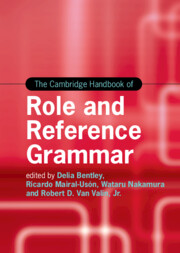Book contents
- The Cambridge Handbook of Role and Reference Grammar
- Cambridge Handbooks in Language and Linguistics
- The Cambridge Handbook of Role and Reference Grammar
- Copyright page
- Dedication
- Contents
- Figures
- Tables
- Contributors
- Pedagogical Guide to The Cambridge Handbook of Role and Reference Grammar
- Introduction
- Part One Overview
- Part Two Topics in RRG: Simple Sentences
- Part Three Topics in RRG: Complex Sentences
- Part Four Applications of RRG
- Part Five Grammatical Sketches
- 22 A Grammatical Sketch of Cheyenne (Plains Algonquian, USA)
- 23 A Grammatical Sketch of Yimas (Lower Sepik, Papua New Guinea)
- 24 A Grammatical Sketch of Avatime (Kwa, Niger-Congo, Ghana)
- 25 A Grammatical Sketch of Amele (Papuan, Papua New Guinea)
- 26 Case and Voice in Amis (Austronesian, Taiwan)
- Index
- References
22 - A Grammatical Sketch of Cheyenne (Plains Algonquian, USA)
from Part Five - Grammatical Sketches
Published online by Cambridge University Press: 08 June 2023
- The Cambridge Handbook of Role and Reference Grammar
- Cambridge Handbooks in Language and Linguistics
- The Cambridge Handbook of Role and Reference Grammar
- Copyright page
- Dedication
- Contents
- Figures
- Tables
- Contributors
- Pedagogical Guide to The Cambridge Handbook of Role and Reference Grammar
- Introduction
- Part One Overview
- Part Two Topics in RRG: Simple Sentences
- Part Three Topics in RRG: Complex Sentences
- Part Four Applications of RRG
- Part Five Grammatical Sketches
- 22 A Grammatical Sketch of Cheyenne (Plains Algonquian, USA)
- 23 A Grammatical Sketch of Yimas (Lower Sepik, Papua New Guinea)
- 24 A Grammatical Sketch of Avatime (Kwa, Niger-Congo, Ghana)
- 25 A Grammatical Sketch of Amele (Papuan, Papua New Guinea)
- 26 Case and Voice in Amis (Austronesian, Taiwan)
- Index
- References
Summary
This grammatical sketch explores sentence structure in Cheyenne/Tsêhésenêstsestôtse (Plains Algonquian, USA). We first describe the principal morphosyntactic features of Cheyenne and offer a brief account of grammatical phenomena that benefit from a Role and Reference Grammar (RRG) analysis: basic clause types, verb valence and transitivity, the marking of core arguments, argument-adjuncts and adjuncts, and the linking algorithm. This analysis shows that there is no evidence for the postulation of grammatical relations, save for a pragmatically influenced privileged syntactic argument, and supports the hierarchical scope order of operators postulated by RRG. We then illustrate the fundamental role of pragmatics in argument coding, macrorole assignment, and word order by examining the relationship of information structure with the reference-tracking system of obviation and the direct/inverse system. These systems work jointly with the Person and Semantic Function Hierarchies. Despite word order variability, it is possible to integrate information structure into clause structure and explore the intricate mechanism that accommodates semantic information into syntactic structure.
Keywords
- Type
- Chapter
- Information
- The Cambridge Handbook of Role and Reference Grammar , pp. 823 - 860Publisher: Cambridge University PressPrint publication year: 2023



